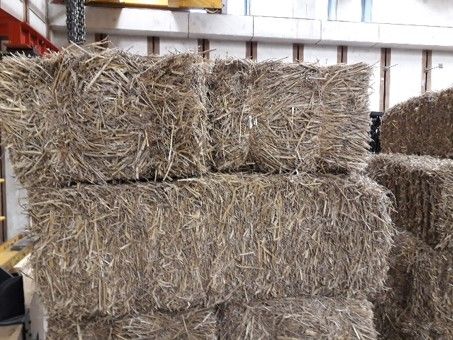University of Bath – Progress on prototype 3
Create a subpage- Sylvain Bosquet
- /
- the 10-07-2018
- / 1504
The SB&WRC project is supported by the European program Interreg VA France (Channel) England and receives financial support from the ERDF.

The University of Bath is focusing on the design and production of a thermal insulant for buildings made from wheat straw. This cereal straw is readily available in the Interreg (Channel) region of Northern France and Southern England with an estimation of around 3.3 million tonnes in the French Interreg area and around 2.3 million tonnes in the English Interreg area.
The current research work has focused on the characterisation of the straw as a raw material, before studying the straw bale as a prototype insulation material. Some physical, biochemical and hygric properties of a French straw and a English straw are assessed and compared with each other. The two straws are visibly different in their colour, with the French straw yellow whereas the English straw is greyer; this difference is most likely due to storage of the straw following harvesting. Their initial moisture contents, around 9% for the English straw and around 24% for the French straw, are also different. Their bio-composition, namely their cellulose, hemicellulose and lignin contents, will be assessed with the Van Soest method (Van Soest et al., 1991). Only the English straw has been tested so far: it is mainly composed of cellulose (54%) with hemicellulose (27%) and lignin (9%) the other major constituents.
The hygrothermal performance of a material is highly influenced by its porosity, so the focus has been on understanding these properties. The pore size distribution of the straw is evaluated by means of the Mercury Intrusion Porosimetry (MIP) which consists of measuring the volume of mercury penetrating in the pores of a material as a function of the pressure applied. The English and the French straw have a similar pore size distribution with an average diameter of 157 nm for the English straw and 117 nm for the French straw. The density of an individual piece of straw can also be found with the MIP test. The true density of 1.43 g.cm-3 is obtained for the English straw and 1.40 g.cm-3 for the French straw, which led to a calculated porosity of 79% and 86% respectively.
This difference in porosity is highlighted by the water absorption of the straw by immersion. After 48h of immersion, the French straw absorbed 390% of its weight whereas the English straw absorbed only 290%. While water adsorption can lead to bio-degradation, there are many other beneficial properties for the regulation of the indoor environment, through gaseous moisture sorption. Finally, the capacity of the straw to store moisture is assessed with the measurement of the sorption-desorption isotherms carried out with the Dynamic Vapour Sorption instrument, which uses very accurate scales to weigh the straw as the relative humidity increases and decreases. With its porosity, straw seems to have a very good hygric property with a good sorption capacity (21% of moisture content at 95% of relative humidity for the English straw). This should play a positive role in the moisture regulation of an indoor environment.
The next steps of the investigation will deal with the baling of the straw and the study of hygrothermal properties according to the straw orientation in the prototype insulation material.
Sraw bale building is not new. It is over 100 years old. There are nationale straw-bale organisations in nearly every country RFCP, ASBN, FASBA...., and there are already a lot of studies made.
There is also an europeen association ESBA www.strawbuilding.eu
